The Federal Reserve (Fed) Bank of Philadelphia President Patrick Harker recently commented on the US central bank’s successful navigation through a challenging economy in recent years. Harker emphasized the importance of finding a balance in monetary policy, likening it to driving a bus where speed needs to be managed effectively. He also highlighted the significance of achieving maximum employment, focusing on job quality rather than just quantity. Additionally, Philadelphia Fed conducts research beyond monetary policy and considers both “hard” and “soft” data in decision-making processes. Fed’s role in bank supervision and financial stability was also recognized, with ongoing exploration of the impacts of AI and quantum computing on finance. Harker also mentioned potential risks such as inflation decline stalling and softening of the labor market.
Following Harker’s comments, the US Dollar Index (DXY) was trading slightly higher at 100.80 on the day. This indicates a market reaction to the discussion on the Federal Reserve’s strategies and potential risks mentioned by Harker.
As a crucial player in the US economy, the Federal Reserve (Fed) plays a significant role in shaping monetary policy. The Fed’s dual mandates are to achieve price stability and foster full employment, primarily through adjusting interest rates. When inflation exceeds the 2% target, interest rates are raised to curb borrowing and strengthen the US Dollar. Conversely, when inflation falls below 2% or unemployment is high, interest rates may be lowered to encourage borrowing and investment, which could weigh on the Greenback.
The Federal Reserve holds eight policy meetings a year, during which the Federal Open Market Committee (FOMC) evaluates economic conditions and makes monetary policy decisions. The FOMC comprises twelve Fed officials, including the Board of Governors, the president of the Federal Reserve Bank of New York, and four regional Reserve Bank presidents serving on a rotating basis. In extreme circumstances, the Fed may implement Quantitative Easing (QE), a policy to increase credit flow during financial crises or low inflation periods. QE involves purchasing high-grade bonds with printed money, weakening the US Dollar.
Quantitative Tightening (QT) is the reverse of QE, where the Fed stops buying bonds and does not reinvest in new ones, which can strengthen the US Dollar. QT is seen as a positive measure for the US currency. These policies are instrumental in stabilizing the economy and ensuring the Fed fulfills its mandates of price stability and full employment. The ongoing exploration of technological advancements such as AI and quantum computing also reflects the Fed’s commitment to staying ahead in the financial landscape. Harker’s warnings about potential risks such as inflation decline and labor market softening indicate the ongoing challenges faced by the US economy, highlighting the need for proactive measures and policy adjustments by the Fed.
















